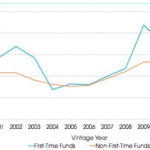Still White, Still Male: New Report Quantifies Impact Investing’s Diversity Problem
“Imagine – it is 4:00 pm, and you walk into a playground full of mothers, chatting to each other, and their children are running around, laughing, screaming. How would you feel?”
That was my question to the (predominantly male) audience when I led a diversity workshop at The Gathering, a convening for the 100 most active social investors in the UK, two years ago. At that moment, looking out at a room full of white men, I felt like I didn’t belong – and I wanted to convey that feeling to the group.
I had decided that sparking the conversation about the lack of diversity within impact investing was urgent. As interest had started to grow in impact investing, big money from institutional investors was started to pour in, and the sector had arrived at an inflection point. At that time, it was more important than ever to have an honest reflection about whether we as social investors were perpetuating the inequalities we seek to address by overlooking the lack of broader representation in our own ranks. I was worried that the people making impact investment decisions were so far removed from the realities of the communities we seek to serve, and that these diverse voices were not represented at the table.
So, I spoke up – as a young woman of colour, not really expecting to be heard. To my surprise, the workshop was a success: Many people told me it resonated with them, and after the conference, a group of us came together to continue the conversation. We started an informal network to champion diversity, which we gradually formalised into the “Diversity Forum.” The forum is a collective of individuals on a mission to drive inclusive social investment in the U.K., by convening sector-wide groups, commissioning research and sharing knowledge. We don’t believe in diversity for diversity’s sake, but rather, diversity for inclusion’s sake. Diversity counts the numbers, but inclusion makes the numbers count.
How Diverse is the Social Investing Sector?
Before we started the Diversity Forum, there were a few surveys floating around to try to answer the question: How diverse is the social investment sector? Yet no systematic research had been done, so in order to diagnose the problem, we commissioned a research study with support from the Connect Fund. We knew already that there are ceilings for women trying to get into top positions, and ethnic minorities hoping to get into front office functions – but what led to these ceilings? We also had little understanding of how other diversity characteristics are represented in our sector – including disability, class, sexuality and age. Above all, we had almost no understanding of intersectionality, the concept that multiple identities, such as age, gender and race, intersect. How do diversity strands interact with each other, and do some groups face intersectional invisibility – in which discrimination that results from one’s overlapping identities may be invisible to others? These were complex questions, but we were in the safe hands of Inclusive Boards, an experienced research agency, which we contracted to investigate these questions.
The report was launched last week at the British Parliament, and we chose the venue precisely because we wanted the report to receive attention from policy-makers. The report has many sobering findings, but we hope it will prompt the social investment sector to make some important changes. We also hope this will inspire other sectors to follow suit, as the diversity problem is one that we see across the broader society – both in the U.K. and internationally.
Disturbing Findings
The report has indicated an evident lack of gender, disability, ethnic and socio-economic diversity in senior positions and at the board level, throughout the social investment sector. Some key findings include:
- While the sector’s workforce is more ethnically diverse than the broader population, with 23 percent of respondents from black, Asian and minority ethnic (BAME) backgrounds compared to 14 percent of the wider population (according to the 2011 Census), this diversity is not reflected at the top of the hierarchy. Only 6.5 percent of board directors are from BAME backgrounds, and the likelihood of having access to attend a board meeting is even smaller for BAME women, who represent only 2.8 percent of all directors.
- The report also shows that almost one in five Board directors (18 percent) in the sector attended Oxford or Cambridge universities. This compares to just 1 percent of the entire U.K. population, illustrating the challenge of accessing directorship positions for someone who comes from an underprivileged background, and is therefore less likely to attend those universities.
- Women also face barriers to climbing the ladder and holding a directorship or executive position: Male directors outnumber female directors by a ratio of 2:1, and male executives by 3:2. But interestingly, female directors are more likely to have a background in the charity sector before joining the social investment sector.
- Finally, people with disabilities are severely underrepresented, with only 7 percent of respondents identifying as having a disability, compared to 16 percent of working age adults in the broader population.
The Case for Optimism
Seeing these statistics may be frustrating, but there is certainly a case for optimism. First, we believe that the small size and relatively young age of the impact investing field means there is an opportunity to drive change and lead by example in this area. Second, we have already seen a lot of actions – from just a few of us leading the diversity efforts back in 2017, to close to 200 people involved in the efforts today (including 20 leaders who signed our Manifesto, 60 professionals who have become “Diversity Champions” and 125 professionals who participated in our research). Third, we have compiled our learnings from the past year into a practical toolkit that provides investors with a better grasp of how to approach the diversity issue, and where they could start.
Even though they’re U.K.-centric, these findings are relevant to (and likely reflected in) the global impact investing sector. Diversity challenges exist in every part of the world, even though they may be manifest differently – for instance, in some countries, ethnic diversity may be less relevant – but it is safe to say that diversity of gender, class, sexuality, age and disability is relevant everywhere. The issue of diversity and inclusion is particularly pertinent for investors in developed markets focused on emerging markets. In these contexts, the power imbalance is even more stark, and potentially complicated by the colonial legacy. What does diversity and inclusion in impact investing mean in a global context? That is a much bigger question that will require concerted efforts among investors across countries to answer.
Our efforts in the U.K. are still in their early days, as we’re confronting a wide and deep problem. If we are serious about making impact investing work for everyone, we have to open the door for people from diverse gender, disability, ethnic and socio-economic backgrounds to join the decision-making process. This means shaking up the status quo and getting out of our comfort zones to chart a new, unknown future. If we put our hearts and heads together to solve this, hopefully we will be able to make impact investing – and investing more broadly – truly inclusive.
Bonnie Chiu is the Managing Director of The Social Investment Consultancy.
Photo courtesy of Hannah Busing.
- Categories
- Investing
- Tags
- impact investing, research



